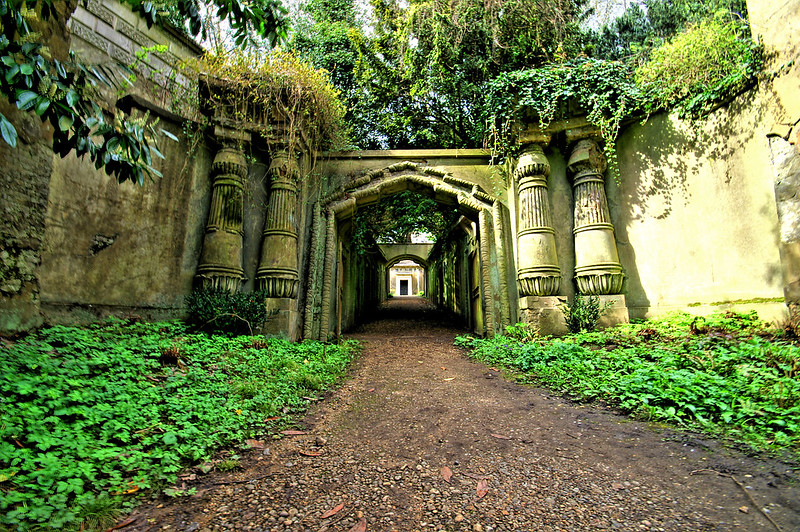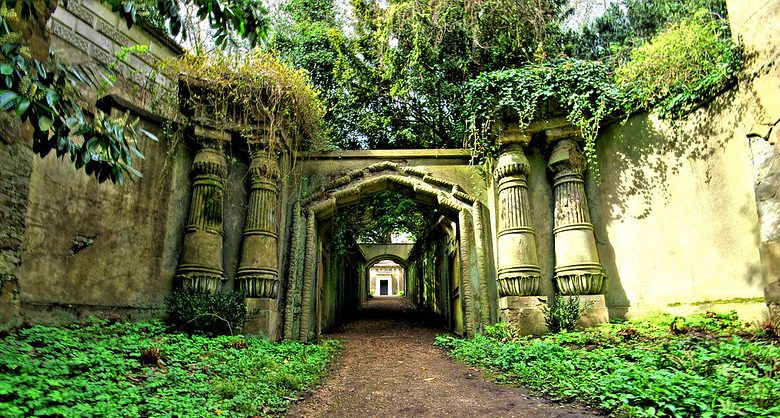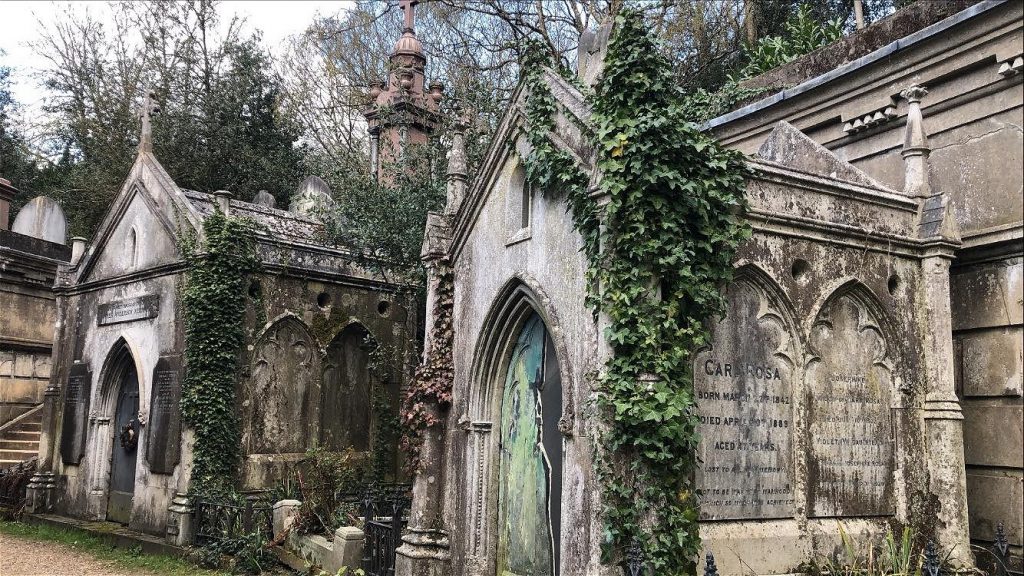
Mottled branches reach for the sky, and an ocean of softly deteriorating stone graves, rubbed by hands as much as time, welcome the visitors of Highgate East cemetery. Visiting the prestigious and historical burial ground, one is quick to notice the sudden and stupendous shift in the towering substructures. The East cemetery is home not only to the dead, but to a fascinating ‘egyptomania’ influence of Victorian era Britain: the Egyptian Avenue.
An obsession with ancient Egypt is commonly referred to as egyptomania. From Katy Perry’s ‘Dark horse’ video (2013) to the Washington monument in Washington D.C., one definition of the term refers to the endless ways ancient Egyptian motifs are repurposed in modern-day trends and projects.
“One of the most stunning sights of the Cemetery, a bit of ancient Egypt has found its way to north London,” reads the official website of Highgate.
And indeed, well beyond the statue of a dog reclining fondly on Victorian bare-knuckle boxer, Thomas Sayers (1826-1865)’s tombstone, and the dozen standing angel statues with wings frozen mid-flutter amidst a mass of euphemisms etched onto tombstones, lies the all-too-recognizable makeshift ancient Egyptian-inspired structures.
Visitors and passersby whisper to one another, evincing no symptom of discomfort or judgment that the burial ground seems to be attracting as many living as dead.
Make no mistake that Highgate cemetery is famous, divided into East and West; it houses significant historical figures such as Karl Marx, George Elliot, and Doulglas Adams among others.
Originally, the cemetery was only composed of one section ‘East’, only expanding to a ‘West’ side when its counterpart quickly filled up. Today, both sections of Highgate – cumulatively gathering over 150,000 burials – make for one of the “Magnificent Seven” of London’s private cemeteries which were created to compensate for the overcrowded graveyards of the capital in the 19th century.

What is the ‘Egyptian Avenue’ and what’s so Egyptian about it?
The Egyptian avenue is an easily recognized section of the cemetery. As one walks along the main path, they are suddenly led to an Egyptian-inspired gateway which is flanked by two columns on each side. The avenue retains its name from the fact that it leads to a circular enclosure called the Circle of Lebanon, and within it lies a small pathway in which visitors can walk along, admiring the substructures.
It is estimated that the 16 vaults comprising the Egyptian Avenue contain 224 buried individuals; originally they were meant to hold permanent and temporary burials.
Atypically, the columns fronting the avenue take the shape of closed lotus flowers, as can be commonly seen in the temples of Luxor and Karnak in Egypt. Moreover, the vaults are fronted by a door adorned with a typical ancient Egyptian feature – the cavetto cornice, a concave moulding that is an architectural feature typically found above the doors of special buildings.
Naturally, there are more characteristics of ancient Egyptian art and architecture. Nonetheless, the columns and the cavetto cornice are a regular staple in Egyptomania, proving to be, alongside the motif of the Sphinx, pyramids, hieroglyphs, and obelisks, very popular in American and British works of art which hoped to imbue paintings, furniture, and buildings with exoticism and orientalism experienced in Egypt.
A reflection of Egyptomania
London’s highgate cemetery is not the only location in the British capital to pay homage to ancient Egypt. Located in Hampstead Road, the Carreras Tobacco Company, now a den for various offices, also offers an ostentatious display of egyptomania: two resplendently black Bastet statues sit at the entrance of the building, the facade is distinguished by lotus-topped columns adorned in blue while the cavetto cornice is striped in red paint.
Like the Egyptian Avenue, the building inspires a double-take, as it only takes seconds for the common passerby to spot the Egyptian art deco which clearly stands out against its Victorian architectural gothic style of Camden.
Transcending mere aesthetic experimentation, the Egyptian features betray a long-standing trend in the West: ever-present egyptomania.
“When the Cemetery was founded, interest in ancient Egypt was still very strong, encouraged by Napoleon’s campaigns,” reads once again Highgate’s website.
It was precisely this prediction for ancient Egypt that inspired a wave of recreation and inspiration from the 1800 onwards across all of Europe. According to Jean Marcel-Humbert’s 1998 article ‘Dream architecture: the architecture of Egypt’, this long-held fascination with ancient Egypt sparked a maelstrom of creation and innovation, as architects and art-makers drew inspiration from the lexicon of Egyptian art and architecture in order to form a fit with the sensibilities of modern times.
“Egypt has always been considered as the land of knowledge and the crucible of science, and public buildings intended for culture and popular education, such as museums, libraries, university buildings or pavilions of zoological gardens, have naturally appropriated Egyptian architectural features […],” Marcel-Humbert states.
Nonetheless, it is specifically in European and North American cemeteries that egyptomania was propelled further, such as in the cemeteries of Terre Cabade in Toulouse (France), Alberobello in Puglia (Italy), and Grove Street in Connecticut (USA). Evoking ancient Egyptian art, Marcel-Humbert underscores, was a way to also tap into the intimate funerary beliefs of the ancient Egyptians and give the modern deceased the protection of eternal afterlife.
The Egyptian Avenue’s is then, a clear marriage between the Egyptian style of architecture and a specific memorialization of the dead. Like countless facades and buildings across the world, it celebrates the perpetually rejuvenating enthusiasm for ancient Egypt which retained its strength for centuries past, and perhaps, for centuries to come.








Comments (3)
[…] UK Egyptomania: The Curious Case of the Egyptian Avenue in Highgate Cemetery […]
[…] UK Egyptomania: The Curious Case of the Egyptian Avenue in Highgate Cemetery […]